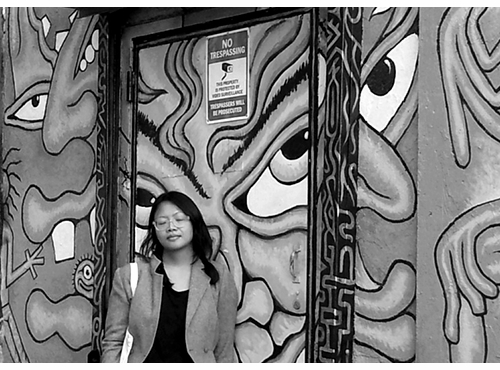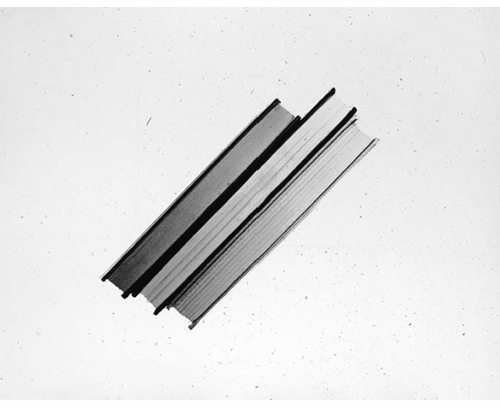| RECENT POSTS DATE 1/1/2026 DATE 12/25/2025 DATE 12/16/2025 DATE 12/11/2025 DATE 12/9/2025 DATE 12/8/2025 DATE 12/3/2025 DATE 11/30/2025 DATE 11/27/2025 DATE 11/24/2025 DATE 11/22/2025 DATE 11/20/2025 DATE 11/18/2025
| | | EMMY CATEDRAL | DATE 2/23/2015For those who couldn't make the February 10 New York Public Library panel, Trends in Art Book Publishing, organized by NYPL Senior Librarian Arezoo Moseni alongside the College Art Association's annual conference, our own Emmy Catedral contributes a review with links to the podcast and panelist Lisa Pearson's galvanizing originating text, On the Small and the Contrary, which should be read by anyone interested in passionate publishing.
ABOVE: Ed Ruscha, "Books," 2001, silver gelatin print.
BY EMMY CATEDRAL
The podcast of last week's Trends in Art Book Publishing panel at the New York Public Library is now available. For the event, Librarian Arezoo Moseni assembled a panel of top names in art book publishing to discuss trends and investigate exactly what makes an art book life-changing, groundbreaking and successful in either the commercial or academic marketplace. (The 2015 panel continued a discussion held in the same space almost exactly two years ago, in which ARTBOOK | D.A.P. President and Publisher Sharon Gallagher delivered a paper on Imagining the Future Art Book.)
Among the panelists were Deborah Aaronson, Vice President and Publisher at Phaidon; Todd Bradway, who spent many years wearing a range of hats at ARTBOOK | D.A.P.—including Director of Title Acquisitions—and is now Director of Publishing of the newly formed David Zwirner Books; Patricia Fidler, Publisher for Art & Architecture at Yale University Press; Lisa Pearson, founder and publisher of Siglio Press; and Mark Polizzotti, Director of the publications program at The Metropolitan Museum of Art.
"The fundamental mission of a publisher is to make public," Moseni wrote in her description of the panel, echoing Marcel Broodthaers' famous dictum, "The field of artistic activity occurs, first of all, in the field of distribution." The panelists agreed, art book publishing exists to make public, to make accessible, to distribute. The multiple exists to reach, for one copy to go where another couldn't, to quote Beuys, "in case something different happens in the future." Thus, an overarching spirit of accessibility was clear from the onset of Moseni's introduction straight through the panelists' discrete presentations, each of which offered several branches of possibilities.
Pearson, who publishes Siglio out of her own garage, was the speaker working on the smallest scale. The beginning of her presentation emphasized the idea that for her there is no such thing as "the" definitive trend but instead many indefinite trends. In her publishing program, she strives to publish each book in a unique format that is true to the artist's vision, each title calling for a new model, and in this mode escaping any kind of codification of a trend. Pearson's mode of working is inspired by the form of the Small and the Contrary. She writes, "The subversion—in the works Siglio publishes and in the ways it publishes them, in the content and in the form of those books—begins by looking askew at the accepted paradigms, locating their absurdities and constraints, and then imagining other possibilities. Thus, the invisible is rendered visible, unexpected connections are revealed, categories dissolved, and a space is opened for contradiction, heterodoxy, ambiguity, as well as wonder." What a beautiful way to think.
Other presentations took on general interest bigness versus nuanced yet powerful smallness, with occasional convergence of opinion. Two years after Imagining the Future Art Book (click here for the audio file from the 2013 panel), what was clear is that the art book continues to insist on being committed to print. Art books are not threatened by the onset of digital forms, as many of us have feared at one point or another. So far no digital manifestation has come close in accessibility or form to the perfect technology of the physical book.
In 2010, Rick Poynor, the influential writer on visual culture, predicted that the rapid expansion of digital technology would bring forth a new "golden age of printing," begging the question of what really does deserve to be committed to print. Towards the end of her panel, Moseni asked the panelists what they imagined for the future art book form. What of an art book that can be worn, for example?
Polizzotti responded that perhaps the revolutionary future book would be imagined by some kid tinkering in a garage. Perhaps in another two years, a third installment in this conversation will provide an answer.
EMMY CATEDRAL is an artist who hosts occasional amateur astronomy salons, as well as Manager of Publisher Services at ARTBOOK | D.A.P. In 2014, she co-organized a performance inspired by Siglio Press' Robert Seydel: Book of Ruth.
| |
|

